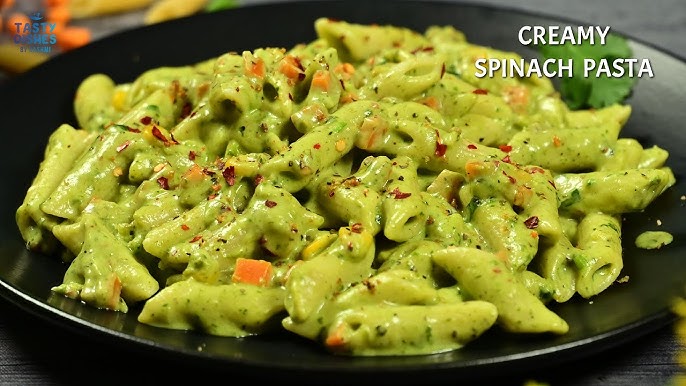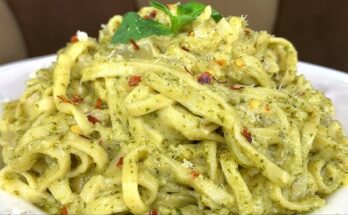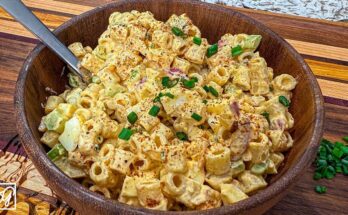Spinach Pasta Recipe: Spinach pasta isn’t just a visual treat with its vibrant green hue—it’s also a powerhouse of nutrition. This pasta incorporates fresh spinach into the dough, adding essential vitamins like A, C, and K, along with iron, fiber, and antioxidants. Unlike white flour-only pasta, spinach pasta offers more nutrients while still maintaining the soft, chewy texture pasta lovers crave. Whether you’re aiming to eat healthier or just love greens, spinach pasta makes a nutritious swap without compromising on flavor or comfort.
Incorporating spinach into pasta is an easy way to sneak more greens into your meals, especially for picky eaters or kids who usually run from vegetables. Once mixed into the dough, the spinach flavor becomes subtle, enhancing the taste rather than overpowering it. Plus, you get the benefit of added fiber and antioxidants that can boost your immune system and digestion.
The Appeal of Homemade Spinach Pasta
Store-bought pasta can be convenient, but there’s something deeply satisfying about making your own from scratch. Homemade spinach pasta is fresher, tastier, and customizable. You control the ingredients, avoiding preservatives and additives found in packaged varieties. The process itself is almost therapeutic—kneading dough, rolling it out, cutting it into shapes. It’s like culinary yoga with a delicious reward at the end.
When you make spinach pasta at home, you also get to tailor it exactly to your preference—thicker or thinner noodles, more spinach for a deeper color, or different types of flour for varied textures. And if you’ve got a pasta machine, it becomes even easier and more fun to involve the whole family in the process.
Ingredients Needed for Spinach Pasta
Fresh Ingredients for Maximum Flavor
To get that fresh, vibrant flavor and texture, use high-quality, fresh ingredients. Here’s your basic list for the dough:
- 2 cups all-purpose flour (or a mix of semolina and all-purpose for extra bite)
- 2 large eggs
- 1 cup fresh spinach (blanched and finely chopped or puréed)
- 1 tablespoon olive oil
- ½ teaspoon salt
Fresh eggs and good olive oil add richness to the dough. The spinach should be fresh and clean—baby spinach works well due to its tenderness and subtle flavor. You can also use frozen spinach, but make sure it’s fully thawed and excess water is squeezed out.
If you’re aiming for gluten-free or vegan, there are easy substitutions. Use gluten-free flour blends and swap out eggs for flax eggs or water and extra olive oil. While it may change the texture slightly, the end result will still be delicious.
Optional Add-ins for Variety
To jazz up your pasta even more, consider mixing in herbs or spices:
- Garlic powder or crushed garlic (for an extra punch)
- Nutmeg (a classic pairing with spinach)
- Basil or parsley (for a green-on-green flavor)
- Parmesan cheese (for added umami in the dough)
These extras can elevate your pasta from great to gourmet, depending on your taste preferences. Just be careful not to overload the dough with moisture-heavy ingredients as it can affect the texture.
Step-by-Step Guide to Making Spinach Pasta
Step 1 – Preparing the Spinach
The first and most crucial step is preparing your spinach properly. If you’re using fresh spinach:
- Rinse it thoroughly to remove dirt.
- Boil or steam for 1–2 minutes until wilted.
- Drain well and run under cold water to stop the cooking.
- Squeeze out all the moisture—use a kitchen towel or cheesecloth.
- Chop it finely or use a food processor to purée it.
This step ensures the spinach blends smoothly into the dough without making it soggy. If you’re using frozen spinach, thaw completely and squeeze out excess moisture before using.
The purée should be as dry as possible. Too much water content can make your dough sticky and hard to work with. You want a thick, dense spinach paste that mixes evenly into your flour and eggs.
Step 2 – Mixing the Dough
Now comes the fun part—making your dough. On a clean countertop or in a mixing bowl:
- Make a mound with your flour and create a well in the center.
- Crack in your eggs, add the spinach purée, olive oil, and salt.
- Using a fork or your fingers, slowly mix the flour into the wet ingredients from the inside out.
- Keep combining until it starts to form a shaggy dough.
At this point, it will look a bit messy—don’t worry, that’s normal. The spinach will give the dough a beautiful green tint. Once most of the flour is incorporated, it’s time to knead.
Step 3 – Kneading and Resting the Dough
Kneading is where your dough really starts to come together. This part requires some muscle but it’s worth every minute. To knead:
- Dust your work surface lightly with flour.
- Take the rough dough and begin pressing it with the heel of your hand.
- Fold it over itself, turn, and repeat.
Do this for about 10 minutes. You’ll notice the dough becoming smooth and elastic. If it’s too dry, wet your hands slightly and knead again. If it’s too sticky, sprinkle a little more flour on the surface. The perfect dough should feel firm but pliable—not crumbly or overly tacky.
Once kneaded, form the dough into a ball, wrap it tightly in plastic wrap, and let it rest at room temperature for at least 30 minutes. Resting helps relax the gluten and makes the dough easier to roll out. It also gives the flavors time to meld, enhancing the spinach’s subtle earthy taste.
You can also refrigerate the dough if you want to prepare it ahead of time. Just bring it back to room temperature before rolling it out.
Step 4 – Rolling Out the Dough
After resting, your dough is ready to be transformed into beautiful green pasta sheets. Cut the dough into quarters so it’s easier to manage, keeping unused portions wrapped to avoid drying out.
If you have a pasta machine:
- Flatten one portion of dough with your hands or a rolling pin.
- Run it through the widest setting of your pasta roller.
- Fold in half and repeat a few times until smooth.
- Gradually reduce the settings until your desired thickness is achieved.
If rolling by hand, use a rolling pin to flatten the dough evenly. Aim for a thickness of about 1–2 mm, depending on your pasta type. It takes a bit more elbow grease, but the results are equally satisfying.
Lightly dust your rolled sheets with flour to prevent sticking. Lay them flat on a towel or parchment paper while you work through the rest.
Step 5 – Cutting the Pasta
Once your dough is rolled out, it’s time to decide what shape you want. Here are a few popular choices:
- Tagliatelle or Fettuccine: Roll the sheet loosely and cut into strips.
- Pappardelle: Cut into wider strips, about an inch wide.
- Ravioli: Place filling between two sheets, seal, and cut into shapes.
- Lasagna: Leave sheets whole for layering.
For long pasta, after cutting, gently toss the strands with flour to prevent clumping and lay them in loose nests.
A pizza cutter, sharp knife, or pasta cutter wheel works great here. If you’re making stuffed pasta like ravioli or tortellini, make sure your dough isn’t too thick or too thin to hold the filling and seal properly.
Cooking the Spinach Pasta
Boiling the Pasta to Perfection
Fresh pasta cooks much quicker than dried pasta. Bring a large pot of salted water to a rolling boil. Add your spinach pasta and cook for:
- 2 to 4 minutes for long noodles
- 3 to 5 minutes for stuffed pasta
Taste frequently to check doneness—fresh pasta should be tender but slightly firm to the bite (al dente). Don’t overcrowd the pot; cook in batches if needed. Once done, drain immediately and toss with your chosen sauce.
Never rinse fresh pasta after boiling. The starch helps sauce cling better, making every bite more flavorful. If you’re not ready to serve immediately, toss the pasta with a little olive oil to prevent sticking.
Best Sauces to Pair with Spinach Pasta
Spinach pasta has a mild, earthy taste that pairs well with a variety of sauces. Here are some great options:
- Garlic Butter Sauce – Simple and elegant, letting the spinach shine.
- Alfredo or Cream Sauce – Rich and creamy for indulgent comfort.
- Tomato Basil Sauce – Bright and tangy to balance the greens.
- Pesto Sauce – Layered herbal flavor that complements spinach beautifully.
- Lemon Ricotta Sauce – Light and fresh, ideal for summer meals.
You can also toss it with olive oil, parmesan, and a squeeze of lemon for a minimalist meal. Add roasted veggies or grilled chicken for extra protein.
Final Tips and Serving Suggestions
Storing Homemade Spinach Pasta
Making a big batch of spinach pasta? Great idea! It stores well, both raw and cooked, and makes weeknight dinners a breeze. Here’s how to store it like a pro:
- Fresh (Uncooked) Pasta: Dust it lightly with flour and form into loose nests. Store in an airtight container or ziplock bag in the refrigerator for up to 2 days. For longer storage, freeze it. Just spread the nests on a tray until frozen solid, then transfer to bags or containers. It can last in the freezer for up to 2 months.
- Cooked Pasta: If you’ve already cooked it, toss it with a bit of oil to prevent sticking, then store in an airtight container in the fridge for up to 3 days. You can reheat by tossing in a hot skillet with your sauce or a splash of water.
Avoid storing fresh pasta in the fridge without flouring it—it’ll clump together and be hard to separate. And if freezing, don’t thaw before boiling; cook directly from frozen to avoid sogginess.
Serving Ideas for Different Occasions
Spinach pasta is incredibly versatile. Here are a few creative serving suggestions:
- Date Night: Spinach fettuccine with creamy Alfredo, garlic bread, and a glass of white wine.
- Family Dinner: Spinach spaghetti with marinara and meatballs—a colorful, healthy twist on a classic.
- Kids’ Meals: Use fun shapes like bowties or mini shells, toss with cheese sauce for a sneaky veggie Mac & Cheese.
- Dinner Parties: Spinach ravioli stuffed with ricotta and herbs, served with sage butter—fancy but surprisingly simple.
- Meal Prep: Make and freeze batches of pasta. Boil only what you need, and serve with sautéed veggies or leftover proteins.
For presentation, garnish with freshly grated parmesan, cracked black pepper, or even edible flowers for a gourmet look. A drizzle of good olive oil or a squeeze of lemon can also brighten up the plate.
FAQs about Spinach Pasta Recipe
1. Can I use frozen spinach instead of fresh?
Yes! Just make sure to thaw and squeeze out all the excess moisture before blending it into your dough.
2. Do I need a pasta machine to make spinach pasta?
Nope. While a pasta machine helps with even thickness, you can roll the dough by hand with a rolling pin and still get great results.
3. Can I make spinach pasta gluten-free?
Yes. Use a gluten-free flour blend, though the texture may differ slightly. You may need to adjust the liquid ratios.
4. How long does homemade spinach pasta last in the freezer?
It stays fresh for up to 2 months if stored properly in airtight containers or freezer bags.
5. What’s the best sauce for spinach pasta?
Spinach pasta pairs beautifully with garlic butter, creamy Alfredo, fresh tomato basil, or even just olive oil and parmesan.
Conclusion
Spinach pasta is more than just a pretty green noodle—it’s a celebration of flavor, health, and creativity. Whether you’re a seasoned cook or a beginner in the kitchen, making spinach pasta from scratch is a rewarding experience. With just a few ingredients and a little time, you’ll have a delicious, nutritious, and visually stunning dish that can be customized for any occasion.
Not only does it add a nutritional punch to your plate, but it also impresses guests and makes everyday meals feel a bit more special. Plus, once you’ve mastered the basic recipe, the possibilities for customization are endless. So roll up your sleeves, grab some spinach, and start your pasta-making adventure today!



